
Identify the
amide, and
a.  c.
c.  e.
e. 
Darvon ibuprofen penicillin G
(analgesic) (analgesic) (an antibiotic)
b.  d.
d. 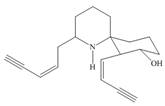 f.
f. 
pregabalin histrionicotoxin pyrethrin I
trade name Lyrica (poison secreted by a (potent insecticide
(used in treating chronic south American frog) from chrysanthemum)
Pain)
(a)
Interpretation: The functional groups present in the given molecule is to be classified and the classification of each alcohol, alkyl halide, amide, and amine as
Concept introduction: The table representing the general formula of different functional groups according to IUPAC convention is given below.
| General formula | Functional group | Functional group name |
| Alcohol | ||
| Aldehyde | ||
| Ketone | ||
| Amine | ||
| Ether | ||
| Ester | ||
| Alkyl halide | ||
| Double bond | ||
| Carboxylic acid |
The classification of alcohols or alkyl halides depend upon the number of carbon atoms attached to the carbon that contains hydroxyl group or alkyl halide. In case of primary alcohol,
The classification of amines or amides also depends upon the number of carbon atoms attached to the carbon that contains nitrogen atom.
Answer to Problem 3.32P
The functional groups present in Darvon are shown below.
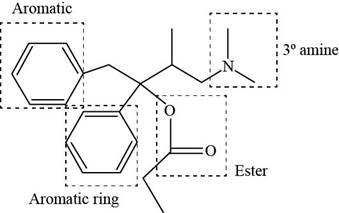
Explanation of Solution
The given compound is,
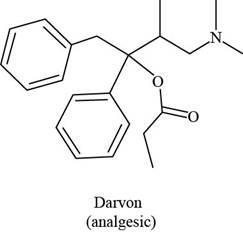
Figure 1
The functional groups present in Darvon are amine, ester and aryl group.
The structure of Darvon that shows the labeling of all functional groups is shown below.

Figure 2
The functional groups present in Darvon and the classification of each alcohol, amide, alkyl halide and amine as primary, secondary, and tertiary are rightfully stated.
(b)
Interpretation: The functional groups present in the given molecule is to be classified and the classification of each alcohol, alkyl halide, amide, and amine as
Concept introduction: The table representing the general formula of different functional groups according to IUPAC convention is given below.
| General formula | Functional group | Functional group name |
| Alcohol | ||
| Aldehyde | ||
| Ketone | ||
| Amine | ||
| Ether | ||
| Ester | ||
| Alkyl halide | ||
| Double bond | ||
| Carboxylic acid |
The classification of alcohols or alkyl halides depend upon the number of carbon atoms attached to the carbon that contains hydroxyl group or alkyl halide. In case of primary alcohol,
The classification of amines or amides also depends upon the number of carbon atoms attached to the carbon that contains nitrogen atom.
Answer to Problem 3.32P
The functional groups present in pregabalin are shown below.
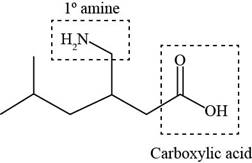
Explanation of Solution
The given structure is,
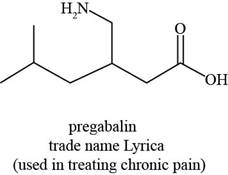
Figure 3
The functional groups present in pregabalin are amine, and carboxylic acid.
The structure of pregabalin that shows the classification of all functional group is shown below.

Figure 4
The functional groups present in pregabalin and the classification of each alcohol, amide, alkyl halide and amine as primary, secondary, and tertiary are rightfully stated.
(c)
Interpretation: The functional groups present in the given molecule is to be classified and the classification of each alcohol, alkyl halide, amide, and amine as
Concept introduction: The table representing the general formula of different functional groups according to IUPAC convention is given below.
| General formula | Functional group | Functional group name |
| Alcohol | ||
| Aldehyde | ||
| Ketone | ||
| Amine | ||
| Ether | ||
| Ester | ||
| Alkyl halide | ||
| Double bond | ||
| Carboxylic acid |
The classification of alcohols or alkyl halides depend upon the number of carbon atoms attached to the carbon that contains hydroxyl group or alkyl halide. In case of primary alcohol,
The classification of amines or amides also depends upon the number of carbon atoms attached to the carbon that contains nitrogen atom.
Answer to Problem 3.32P
The functional groups present in ibuprofen are shown below.
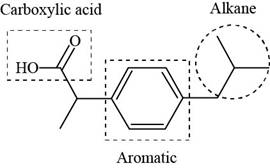
Explanation of Solution
The given structure is,
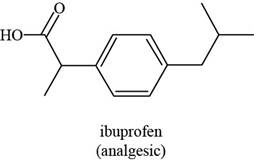
Figure 5
The functional groups present in ibuprofen are carboxylic acid, alkane and aryl.
The structure of ibuprofen that shows the classification of all functional group is shown below.

Figure 6
The functional groups present in ibuprofen and the classification of each alcohol, amide, alkyl halide and amine as primary, secondary, and tertiary are rightfully stated.
(d)
Interpretation: The functional groups present in the given molecule is to be classified and the classification of each alcohol, alkyl halide, amide, and amine as
Concept introduction: The table representing the general formula of different functional groups according to IUPAC convention is given below.
| General formula | Functional group | Functional group name |
| Alcohol | ||
| Aldehyde | ||
| Ketone | ||
| Amine | ||
| Ether | ||
| Ester | ||
| Alkyl halide | ||
| Double bond | ||
| Carboxylic acid |
The classification of alcohols or alkyl halides depend upon the number of carbon atoms attached to the carbon that contains hydroxyl group or alkyl halide. In case of primary alcohol,
The classification of amines or amides also depends upon the number of carbon atoms attached to the carbon that contains nitrogen atom.
Answer to Problem 3.32P
The functional groups present in histrionicotoxin are shown below.
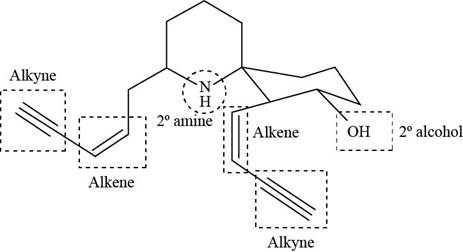
Explanation of Solution
The given structure is,
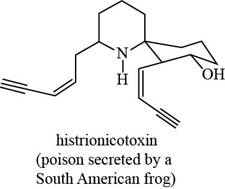
Figure 7
The functional groups present in histrionicotoxin are alkene, alkyne and alcohol. The structure of histrionicotoxin that shows the labeling of all functional group is shown below.

Figure 8
The functional groups present in histrionicotoxin and the classification of each alcohol, amide, alkyl halide and amine as primary, secondary, and tertiary are rightfully stated.
(e)
Interpretation: The functional groups present in the given molecule is to be classified and the classification of each alcohol, alkyl halide, amide, and amine as
Concept introduction: The table representing the general formula of different functional groups according to IUPAC convention is given below.
| General formula | Functional group | Functional group name |
| Alcohol | ||
| Aldehyde | ||
| Ketone | ||
| Amine | ||
| Ether | ||
| Ester | ||
| Alkyl halide | ||
| Double bond | ||
| Carboxylic acid |
The classification of alcohols or alkyl halides depend upon the number of carbon atoms attached to the carbon that contains hydroxyl group or alkyl halide. In case of primary alcohol,
The classification of amines or amides also depends upon the number of carbon atoms attached to the carbon that contains nitrogen atom.
Answer to Problem 3.32P
The functional groups present in penicillin G are shown below.
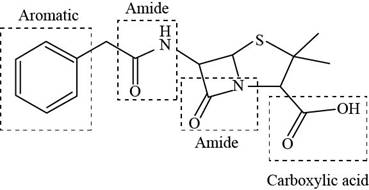
Explanation of Solution
The given structure is,
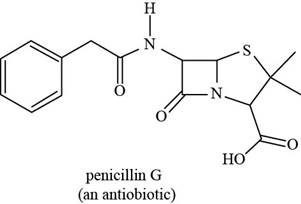
Figure 9
The functional groups present in penicillin G are carboxylic acid, amide, and aryl.
The structure of penicillin G that shows the labeling of all functional group is shown below.

Figure 10
The functional groups present in penicillin G and the classification of each alcohol, amide, alkyl halide and amine as primary, secondary, and tertiary are rightfully stated.
(f)
Interpretation: The functional groups present in the given molecule is to be classified and the classification of each alcohol, alkyl halide, amide, and amine as
Concept introduction: The table representing the general formula of different functional groups according to IUPAC convention is given below.
| General formula | Functional group | Functional group name |
| Alcohol | ||
| Aldehyde | ||
| Ketone | ||
| Amine | ||
| Ether | ||
| Ester | ||
| Alkyl halide | ||
| Double bond | ||
| Carboxylic acid |
The classification of alcohols or alkyl halides depend upon the number of carbon atoms attached to the carbon that contains hydroxyl group or alkyl halide. In case of primary alcohol,
The classification of amines or amides also depends upon the number of carbon atoms attached to the carbon that contains nitrogen atom.
Answer to Problem 3.32P
The functional groups present in pyrethrin I are shown below.

Explanation of Solution
The given structure is,
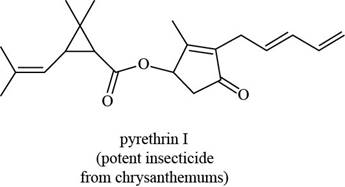
Figure 11
The functional groups present in pyrethrin I are ester, ketone, and alkene.
The structure of pyrethrin I that shows the labeling of all functional group is shown below.

Figure 12
The functional groups present in pyrethrin I and the classification of each alcohol, amide, alkyl halide and amine as primary, secondary, and tertiary are rightfully stated.
Want to see more full solutions like this?
Chapter 3 Solutions
Organic Chemistry
- € + Suppose the molecule in the drawing area below were reacted with H₂ over a platinum catalyst. Edit the molecule to show what would happen to it. That is, turn it into the product of the reaction. Also, write the name of the product molecule under the drawing area. Name: ☐ H C=0 X H- OH HO- H HO- -H CH₂OH ×arrow_forwardDraw the Haworth projection of the disaccharide made by joining D-glucose and D-mannose with a ẞ(1-4) glycosidic bond. If the disaccharide has more than one anomer, you can draw any of them. Click and drag to start drawing a structure. Xarrow_forwardEpoxides can be opened in aqueous acid or aqueous base to produce diols (molecules with two OH groups). In this question, you'll explore the mechanism of epoxide opening in aqueous acid. 2nd attempt Be sure to show all four bonds at stereocenters using hash and wedge lines. 0 0 Draw curved arrows to show how the epoxide reacts with hydronium ion. 100 +1: 1st attempt Feedback Be sure to show all four bonds at stereocenters using hash and wedge lines. See Periodic Table See Hint H A 5 F F Hr See Periodic Table See Hintarrow_forward
- 03 Question (1 point) For the reaction below, draw both of the major organic products. Be sure to consider stereochemistry. > 1. CH₂CH₂MgBr 2. H₂O 3rd attempt Draw all four bonds at chiral centers. Draw all stereoisomers formed. Draw the structures here. e 130 AN H See Periodic Table See Hint P C Brarrow_forwardYou may wish to address the following issues in your response if they are pertinent to the reaction(s) you propose to employ:1) Chemoselectivity (why this functional group and not another?) 2) Regioselectivity (why here and not there?) 3) Stereoselectivity (why this stereoisomer?) 4) Changes in oxidation state. Please make it in detail and draw it out too in what step what happens. Thank you for helping me!arrow_forward1) Chemoselectivity (why this functional group and not another?) 2) Regioselectivity (why here and not there?) 3) Stereoselectivity (why this stereoisomer?) 4) Changes in oxidation state. Everything in detail and draw out and write it.arrow_forward
- Calculating the pH at equivalence of a titration 3/5 Izabella A chemist titrates 120.0 mL of a 0.7191M dimethylamine ((CH3)2NH) solution with 0.5501 M HBr solution at 25 °C. Calculate the pH at equivalence. The pk of dimethylamine is 3.27. Round your answer to 2 decimal places. Note for advanced students: you may assume the total volume of the solution equals the initial volume plus the volume of HBr solution added. pH = ☐ ✓ 18 Ar Boarrow_forwardAlcohols can be synthesized using an acid-catalyzed hydration of an alkene. An alkene is combined with aqueous acid (e.. sulfuric acid in water). The reaction mechanism typically involves a carbocation intermediate. > 3rd attempt 3343 10 8 Draw arrows to show the reaction between the alkene and hydronium ion. that 2nd attempt Feedback 1st attempt تعمال Ju See Periodic Table See Hint F D Ju See Periodic Table See Hintarrow_forwardDraw the simplified curved arrow mechanism for the reaction of acetone and CHgLi to give the major product. 4th attempt Π Draw the simplified curved arrow mechanism T 3rd attempt Feedback Ju See Periodic Table See Hint H -H H -I H F See Periodic Table See Hintarrow_forward
- Select the correct reagent to accomplish the first step of this reaction. Then draw a mechanism on the Grignard reagent using curved arrow notation to show how it is converted to the final product. 4th attempt Part 1 (0.5 point) Select the correct reagent to accomplish the first step of this reaction. Choose one: OA Mg in ethanol (EtOH) OB. 2 Li in THF O C. Li in THF D. Mg in THF O E Mg in H2O Part 2 (0.5 point) Br Part 1 Bri Mg CH B CH, 1 Draw intermediate here, but no arrows. © TE See Periodic Table See Hint See Hint ין Harrow_forwardSelect the product for the following reaction. HO HO PCC OH ○ OH O HO ○ HO HO HOarrow_forward5:45 Х Select the final product for the following reaction sequence. O O 1. Mg. ether 2.D.Oarrow_forward
 ChemistryChemistryISBN:9781305957404Author:Steven S. Zumdahl, Susan A. Zumdahl, Donald J. DeCostePublisher:Cengage Learning
ChemistryChemistryISBN:9781305957404Author:Steven S. Zumdahl, Susan A. Zumdahl, Donald J. DeCostePublisher:Cengage Learning ChemistryChemistryISBN:9781259911156Author:Raymond Chang Dr., Jason Overby ProfessorPublisher:McGraw-Hill Education
ChemistryChemistryISBN:9781259911156Author:Raymond Chang Dr., Jason Overby ProfessorPublisher:McGraw-Hill Education Principles of Instrumental AnalysisChemistryISBN:9781305577213Author:Douglas A. Skoog, F. James Holler, Stanley R. CrouchPublisher:Cengage Learning
Principles of Instrumental AnalysisChemistryISBN:9781305577213Author:Douglas A. Skoog, F. James Holler, Stanley R. CrouchPublisher:Cengage Learning Organic ChemistryChemistryISBN:9780078021558Author:Janice Gorzynski Smith Dr.Publisher:McGraw-Hill Education
Organic ChemistryChemistryISBN:9780078021558Author:Janice Gorzynski Smith Dr.Publisher:McGraw-Hill Education Chemistry: Principles and ReactionsChemistryISBN:9781305079373Author:William L. Masterton, Cecile N. HurleyPublisher:Cengage Learning
Chemistry: Principles and ReactionsChemistryISBN:9781305079373Author:William L. Masterton, Cecile N. HurleyPublisher:Cengage Learning Elementary Principles of Chemical Processes, Bind...ChemistryISBN:9781118431221Author:Richard M. Felder, Ronald W. Rousseau, Lisa G. BullardPublisher:WILEY
Elementary Principles of Chemical Processes, Bind...ChemistryISBN:9781118431221Author:Richard M. Felder, Ronald W. Rousseau, Lisa G. BullardPublisher:WILEY





